EPA puts two NEW ‘forever chemicals’ on the hazard list – and they’re in hundreds of popular cookware and waterproof clothing
The Environmental Protection Agency has added two new forever chemicals to the hazard list found in everyday products such as cookware, furniture and cosmetics.
The agency has designated perfluorooctanoic acid (PFOA) and perfluorooctane sulfonic acid (PFOS) as hazardous substances under the Superfund law, which requires industries to pay for cleanup of toxins that enter the water supply during production.
The compounds are part of a larger cluster of perennial chemicals known as PFAS, which can build up and persist in the human body for long periods of time — and they have been linked to cancer and organ damage.
The measures will hold industries responsible for cleaning up and paying for the perennial chemicals that seep into soil and groundwater, which could cost tens of millions of dollars.
Forever chemicals, also called PFAS, are found in everyday products such as makeup, furniture and nonstick cookware, which can leach into soil and drinking water

The Environmental Protection Agency received $1 billion in funding from the Biden administration to enforce a limit on the amount of permanent chemicals allowed in drinking water. Products such as non-stick cooking pans contain these forever chemicals that end up in the soil and groundwater during the production process. The EPA requires that the chemicals contain less than four parts per trillion

The Environmental Protection Agency received $1 billion in funding from the Biden administration to enforce a limit on the amount of permanent chemicals allowed in drinking water. The EPA requires that the chemicals contain less than four parts per trillion
“No one in 2024 should have to worry about whether their well water, agricultural products or even clothing is contaminated with toxic chemicals, but unfortunately that is the reality for millions of Americans,” said Lisa Frank, executive director of Environment America Research & Policy Center’s Washington office .
Forever chemicals have been used since the 1940s in industrial and consumer products, including nonstick frying pans, water-repellent sporting goods, stain-resistant carpets and cosmetics.
These compounds can easily enter the bloodstream after someone drinks water, wears certain products, or eats food laced with them.
Once in the bloodstream, PFAS can lodge in healthy tissue, where it can damage the immune system, liver, kidneys and other organs.
Under Superfund law, PFOA and PFOS chemicals are not banned, but if they reach or exceed certain levels in soil and water, they must be reported to federal, state or tribal officials.
Forever chemicals are a byproduct of the manufacturing process, where factories that make products containing PFAS emit wastewater that enters communities’ water supplies.
Other pollutants on the Superfund list include lead, asbestos, dioxin – a toxin found in herbicide production and paper bleaching, – soil bioavailability and radiation.
The EPA confirmed Friday that it will focus its enforcement efforts on companies and people that significantly contributed to the release of the forever chemicals into the environment, such as federal agencies and companies that manufactured or used PFAS in the production process.
PFAS are called forever chemicals because of their resistance to natural degradation in the environment and in Americans’ drinking water.
“The chemical industry has been polluting our communities for decades with these ‘forever chemicals,’” said Emily Scarr, director of the U.S. PIRG Education Fund’s Stop Toxic PFAS Campaign.
“We need our state and national leaders to use every tool they can to protect our families from PFAS exposure,” she continued.
“That means phasing out its use, stopping its discharge and holding the chemical industry accountable for the damage they cause to our health and the environment.”

PFAS is a common contaminant in many household items, from cookware to hamburger wrappers. It can remain in the environment and in human tissue for years, even decades, before being cleared

Forever chemicals are found in many foods, including barbecue sauce, hot sogs, sodas and soups. These chemicals can cause fertility problems and life-threatening diseases such as kidney and liver failure and cancer
The move comes after the EPA last week set strict limits on the amount of PFAS that can be present in drinking water, capping them at four parts per trillion each for PFOA and PFOS.
The Biden administration has invested $1 billion in the EPA’s measures that “will reduce exposure to PFAS for 100 million people, prevent thousands of deaths, and reduce tens of thousands of serious illnesses,” the EPA said. said.
The amount of chemicals ending up at sites across the U.S. is growing at an alarming rate, according to the Environmental Working Group (EWG), an agency made up of scientists, policy and data experts, and advocates.
According to the EWG, PFAS has contaminated more than 5,000 locations in all 50 states, and more than 1,200 of those locations have detectable levels of these perennial chemicals.
“For decades, the American people have been exposed to the family of incredibly toxic ‘forever chemicals’ known as PFAS, without any protection from their government,” said EWG President and Co-Founder Ken Cook.
“These chemicals now contaminate virtually all Americans from birth. That’s because PFAS chemicals have slipped from every federal environmental law for generations, like a fried egg from a Teflon pan,” he added.
The American Chemistry Council (ACC), which represents the chemical industry, told DailyMail.com that it strongly opposes the EPA’s action, calling it “seriously flawed” and believing it will “derail overall remediation efforts” for PFAS contamination undermine.
The Superfund law “is an expensive, ineffective and unworkable way to achieve remediation of these chemicals,” the group said, adding that it is “fraught with unintended consequences and will likely result in extensive, unnecessary delays in cleanup efforts.”
Companies introduced PFAS in the 1940s and added them to consumer products including frying pans, waterproof sporting goods, cosmetics and even food packaging, exposing millions of Americans to the harmful and potentially life-threatening toxins.
“This announcement is a critical step to get PFAS out of our waterways and make polluters pay,” Frank said in a statement, adding, “Now we must turn off the tap on toxic PFAS everywhere.”
DailyMail.com has contacted the EPA for comment.
